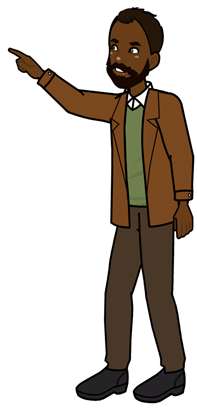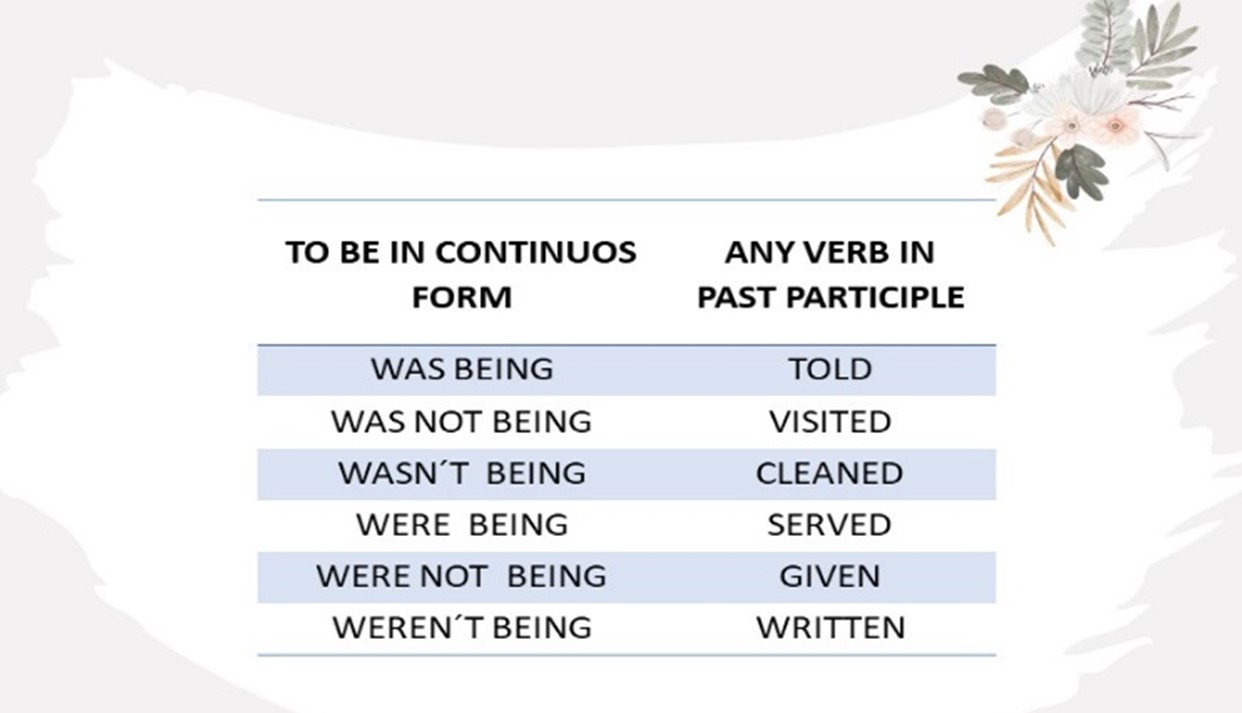I. WHAT IS THE PASSIVE VOICE?

1.1 The Passive Voice is used when we want to emphasize the action (the verb) or the result (the object); NOT the subject (the one who performs the action) because this can be unknown or not relevant. For instance:
Mexican Tenor Rafael Camarena WAS AWARED world recognition as the best singer in 2021.

1.2 WHEN DO WE USE PASSIVE VOICE?
- To emphasize the result of the result or object:
The famous foreign movie Parasite was directed by Bong Joon Ho
- To hide the identity of the subject:
In the past, writers weren´t awarded any nominations.
- There is no subject or the action is done by people in general:
The kitchen was cleaned up this morning.
- When the Object or the Verb becomes the focus of the sentence:
- A very good article on Creativity in Children was published in Amazing Facts Magazine yesterday.
- The Subject can be omitted if we consider it irrelevant.
- The house was built in record time.
1.3 Notice that in the Past Simple, the Passive Voice is constructed using a form of the verb TO BE (was or were_ depending on the subject) and the participle of any verb. For instance:

Here are some examples:
- Miss Reynolds was given an award last school year.
- The students were graded based on their participation.
- The window was broken by the kids.
- My cellphone was stolen just a while ago. I left it on my desk.
- A lot of children were given an opportunity to travel abroad on a scholarship program.
- Those cars were built using the concept model.
- The thief was arrested yesterday afternoon.
- The electric light bulb was invented by Thomas A. Edison
1.4 THE PASSIVE VOICE IN PAST CONTINUOS
In the Past Continuous, the Passive Voice is constructed using a form of the verb be in the past continuous, and the participle of the verb. Look at this chart:

Here are a few more examples:
- What I saw at the construction company yesterday was that a huge wall was being torn down and a bridge was being built.
- What was being written in the 80s in most showbiz magazines?
- Were you being accused by the suspect? Really?
- When we got home yesterday, the TV was on but it wasn't being watched.
II. CONSOLIDATION.
Choose the correct answer to complete the following sentences correctly.
III. EXERCISE I
PART I
Part II
Part III

IV. READING COMPREHENSION AND VOCABULARY BUILDING

EMPLOYABILITY SKILLS: DESCRIBING WAYS TO RESEARCH INFORMATION
Understanding how to research information may be a part of both your educational program as well as your job, not to mention a vital life skill. Being able to efficiently locate information on specific subjects, products, techniques, and other general information can be a great time saver and ensure that the information you locate is of value. The World Wide Web has revolutionized the ways in which people research information. The following are just a few tips on how to research information effectively:
- (SUBHEADING 1)
The first question to answer is: What are the keywords or phrases associated to your research topic? Having a good understanding of what you are looking for will determine the success you have in locating the correct information. Is the topic very general or specific? In general, the more specific your topic, the more complex your search will be. For example, a broad search would be to find some general information on car recalls. A more complex search would be to find information on car recalls in 2019 for a specific manufacturer, including the types of recall, models of cars, and total number of cars affected.
- (SUBHEADING 2)
If you are studying on campus, get to know your library or learning commons. Check out their website and the resources available to you online and in person. In many cases, study and research guides have been prepared by librarians for students by discipline. General tours and information sessions are often provided at the start of the term and a session may also be included as part of your program. Once you’ve narrowed down the topic or identified the information you need to find, you have a number of different resources available to help you gather the information required. These resources may include:
• books, magazines, newspapers, encyclopedias, dictionaries
• scholarly and trade publications
• supplier documentation
• directories, handbooks, manuals
• almanacs
• atlases and gazetteers
• research reports
• government information
• statistics, maps, pictures, photos, images
• expert opinions
• interviews
The information you need may be available in a school or public library, on the Internet, or through personal contacts. Depending on the information you require, you may have to access information in a number of different forms of media. For example, historical information may be available only on microfilm or microfiche. Other information may be on VHC, DVDs, CDs, slides, CD-ROMs, proprietary software/databases, or the Internet.
- (SUBHEADING 3)
Most searches today are conducted using online search engines and databases. Examples of free search engines include Google, Google Scholar, Bing, and Ask. Some search engines are proprietary and are made accessible only through subscription by a library, such as Business Source Complete and Academic Search. There are also a number of private companies that provide access to information for a fee. It is important to keep in mind that many of these proprietary search engines and databases are available to students free of charge through your college library. Always check with your library to see if you can get the information you need for free before purchasing it. Again, your librarian can help you.
There is no specific search engine associated with trades programs. However, understanding your topic will help you find the appropriate search engines you can go to as well as credible websites. For example, if you are asked to research how a specific product is installed, the best site will be the manufacturer’s website where all the information is listed, including the warranties for the installation of their products.
- (SUBHEADING 4)
If the information you need based on the keywords you’ve chosen cannot be found, look for synonyms (alternate words with a similar meaning) or additional criteria to broaden your search to help you locate the material you need. Likewise, if your search yields too much information, you’ll need to narrow it by adding additional keywords or criteria.For example, if you look for a video on trades students and study skills, you will probably not find videos on that specific subject. However, if you open up your search to college students and study skills, you will find many videos that you can review and choose from based on their relevance to trades students. Likewise, if you are looking for information on a famous garden and the search yields too much information, additional search criteria may be added, such as information from the past five years and only in English.
- (SUBHEADING 5)
In order to define your search, you have to know how to use the words “and,” “or,” and “not”, which can either expand or reduce your search significantly. Using search operators and Boolean logic is a must when doing a search. For example, a search on “joinery and Canada” will pull up all information with these two terms. A search on “joinery not Canada” will exclude any information that includes the term “joinery” but not “Canada.” The use of quotation marks around a term isolates your search to the search phrase; for example, “Hockey Night in Canada.” There are many videos and articles available on the Internet that help you understand how to use search operators and Boolean logic.
PRACTICE I.
PRACTICE II.
INSTRUCTIONS Questions 6-10
Choose a, b, c or d to complete the following questions correctly.
PRACTICE III.
BIBLIOGRAPHY
Azar, B. S., Azar, D.A., & Koch R.S. (2009). Understanding and Using English Grammar. Longman.
Barker C. and Mitchell, L. (2004). Mega 1 (First Ed.). Macmillan Publishers.
Hewings, M. (2013) Advanced Grammar in Use with Answers: A Self-Study Reference and Practice Book for Advanced Learners of English. CUP
Murray, L. (2014) English Grammar. Cambridge University Press.
WEB RESOURCES
Images 1 & 2 _ Personal subscription to Pixton
REFERENCES
Chart 1 & 2 Own source .
Image_ Chart 1_Free stock photos_https://www.freepik.com/free-vector/smiling-boys-girls-pointing-banners-blank-empty-posters-sheets-paper-with-copy-space-set_22655987.htm#query=cute%20characters&position=40&from_view=keyword
Image_ Chart 2_https://www.freepik.com/free-vector/watercolor-autumn-flowers-leaves-collection-withbouquet_18986492.htm#query=flower%20sticker&position=3&from_view=keyword
CREDITS
- (2021) Practice exercise written by Connie Reyes_Language Department at ENES-LEON UNAM
- Audio version performed by Sally and Matthew_Voicemker_Text to Speech Converter_Connie Reyes 2022 Subscription
- Synopsis by K.G.F. Vissers. Published in 2020. Part of the text retrieved and adapted from https://www.imdb.com/title/tt1028532/plotsummary
- (2021) Practice exercises written by Connie Reyes_Language Department at ENES-LEON UNAM
- Image3. Free stock photos_ https://www.pexels.com/photo/a-cute-dog-with-it-s-tongue-out-8940562/Photo by Артём Н from Pexels
- Text by Camosun College (2015). The Trades Access Common Core resources are licensed under the Creative Commons Attribution 4.0 Unported Licence, except where otherwise noted. Text retrieved from http://open.bccampus.ca
- (2021) Practice exercises written and adapted by Connie Reyes-Cruz_Language Department at ENES-LEON UNAM
- Audio version performed by Sally-Matthew_Voicemaker_Text to Speech Converter_Connie Reyes 2022 Subscription
- Image_ Connie Reyes 2022 Subscription to Pngtree—modern flat design concept of_5332904